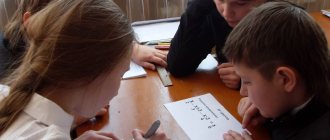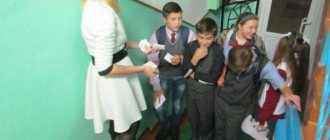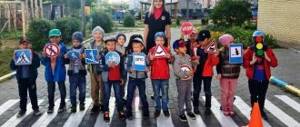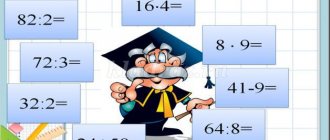Techniques and methods for developing students’ educational motivation in the educational process (from work experience).
In pedagogical practice I use various ways of activation, the main one among them is a variety of teaching methods and techniques, the choice of such combinations that, in situations that arise, increase the level of educational motivation of younger schoolchildren.These methods and techniques should be distinguished by novelty, variety, entertainment, fascination, use of bright artistic means, imagery; include surprise, search, paradox.
Techniques for developing the motivation of a junior schoolchild for educational activities through the content of educational material
The educational and cognitive motivation of students must be supported at every stage of the lesson, starting with determining the topic and formulating the purpose of the lesson and ending with a reflective assessment of the activities of younger schoolchildren in the lesson.
In order to motivate a child to the educational process, you need to start studying a new topic in an unusual form.
To do this, I use the “Attractive Target”
. A simple, understandable and attractive goal is set for students, upon achieving which they, willy-nilly, carry out the educational action that the teacher plans. Example. Topic: “Properties of water.” The teacher’s goal is to review the properties of water with the children. I set a different goal for my students - to find out why water pipes burst during severe frosts in winter.
Sometimes something amazing not only attracts attention, but also holds interest for a long period of time. “Delayed Guess” technique allows me to achieve this.
.
Option 1. At the beginning of the lesson, the class is given a riddle (an amazing fact is stated), the answer to which will be revealed during the lesson when working on new material.
Example: “This is a filter, a stove, and a guard post” (nose)
Option 2. A riddle (surprising fact) is given at the end of the lesson to start the next lesson with. “In the next lesson, students will learn about nature’s best vacuum cleaner.” (Plants, namely poplar). Topic: The air must be clean."
Also, when communicating the topic of the lesson and its purpose, the “Forecasting”
. For example, a literary reading lesson. “Listen to the title of the work we will work with in class, and try to determine the genre of the work, the theme, and possible events.”
To develop interest in the subject being studied, it is necessary to understand the need, importance, and feasibility of studying this topic. The following techniques can help with this:
Reception "Speaker"
. In 1 minute, convince your interlocutor that studying this topic is simply necessary.
"Author" technique
. If you were the author of a textbook, how would you explain to students the need to study this topic?
Reception "Professional"
. Based on your future profession, why do you need to study this topic?
Brainstorming Technique
It is carried out at the initial stages of the lesson, when it is important to get as many answers and ideas as possible in a short period of time.
In order to form the motivation of younger schoolchildren for educational activities, it is useful to cause the reaction of younger schoolchildren to an error through deliberately made mistakes when performing any task, to find out the reasons and determine subsequent actions.
“Catch the mistake!” technique
1. When explaining the material, the teacher intentionally makes a mistake. First, students are warned about this in advance. You can point out “dangerous places” using intonation or gesture. 2. The student receives a text or analysis of the solution to a problem with intentional errors. Assignments can also be prepared by other students.
If the teacher strives to understand the “mistakeable” part, and not to mechanically memorize the answer, then the children will not remember this mistake and will not repeat it.
An important role in shaping the motivation of younger schoolchildren for educational activities can be played by the interruption and incompleteness of educational activities through the creation of a situation of knowledge deficiency and independent determination of the goals of subsequent activities. For this purpose, the following methodological techniques can be proposed.
Reception "Open problems"
1. The teacher deliberately does not fully disclose the topic, inviting students to ask clarifying questions. Questions can be reproductive, expanding knowledge or developing it. Reproductive issues are not interesting. The answer to them is repetition of what is already known. Knowledge-expanding questions allow you to learn new things about the object being studied, clarify what is known, but do not pretend to significantly complicate knowledge. Developmental questions reveal the essence, generalize, and contain a research beginning. (Example: Reproductive questions: Why does an African elephant need ears? Why does an elephant flap its ears? Why are elephant ears riddled with a large number of blood vessels? Questions that expand knowledge: What is the area of an elephant’s ears? How many degrees does the blood cool in the ears? What is the normal temperature of an elephant’s blood? Developmental questions: What other animals use their ears to regulate their temperature? What other ways do animals cool down? Why doesn’t an elephant just sit in the water while it’s hot? What does an elephant do with its ears when it’s cold?)
Technique “Thin and thick questions”
Before studying the educational text, students are formulated with a goal: to compile a list of questions for the text. Sometimes it is advisable to specify their quantity and content. “Subtle questions” require a simple, unambiguous answer. “Thick” questions are problematic questions that require ambiguous answers. (Example of a “thin” question: What are the sides of a right triangle called? Example of a “thick” question: Why is a parallelogram called a “parallelogram”?)
Technique “Look at the world through someone else’s eyes”
. Nothing attracts attention and stimulates the mind like the unusual. Topic: “The Water Cycle” The student is asked to imagine himself as a snowflake. It is necessary to describe all the events that happen to him.
Reception "Sinquain"
Using this technique makes it possible to check the assimilation of the main points of the studied material; creatively rework key concepts of the topic, promotes mental activity of students, maintains a high level of cognitive interest and promotes the formation of learning motivation. Rules for writing syncwine: -1 line - topic (one noun); -2 line - description of the item (two adjectives); -3 line - description of the action of the object (three verbs); - line 4 - a four-word phrase expressing an attitude towards the subject; - Line 5 - a synonym that summarizes or expands the meaning of the topic (one word). (Example: Story Interesting, fascinating Read, learn, imagine I admire the wise story This is a mirror of life!)
Reception "Crossence"
Crossence is an associative chain closed in a standard field of nine squares. Nine images are arranged in such a way that each illustration has a connection with the previous and subsequent ones, and the central one unites several in meaning at once. The use of crossense is possible at various stages of the lesson (at the stage of checking homework, at the stage of formulating and setting the goal of the lesson, at the stage of consolidating and summarizing the material. Solving the crossence reflects the depth of the student’s understanding of a given topic, promotes the development of logical and imaginative thinking, increases motivation for learning activities , develops the ability of self-expression.
At the stage of repeating the studied material, it is important that students find it interesting to work through this material. How can this be done? I use different techniques so that, when completing a task, the student independently and in his own way expresses the knowledge acquired in the lesson.
technique .
The student draws up his own reference diagram or a detailed answer plan for the new material. Drawing up algorithms and memos. Example, algorithm for parsing words by composition.
Technique “Repetition with expansion”
. Students create a series of questions, the answers to which allow them to supplement their knowledge of new material.
Reception “Your own examples”
. Students prepare their examples for new material. It is also possible to write your own problems and put forward ideas for using the material studied.
Technique “Repetition with simultaneous control”
. Students make up a series of test questions for the material studied in class in the form of a test or a crossword puzzle. Then some students ask their questions, others answer them.
To develop motivation for learning activities in a primary school student, the content of homework and the methods of its presentation are of great importance. You can offer “open homework” (according to A.V. Khutorsky), connecting the material being studied with everyday life and with the interests of students. (For example, prepare a message about your pet; review periodical literature, TV shows and prepare a message about your favorite sport). To present homework, you can use the following techniques.
"Unusual Ordinary" technique
Involves the process of assigning homework in an unusual form.
Students are offered words with missing letters related to the study of a particular spelling (for example: ... do, French ... y, r ... stenie, uka ... ka, German ... y, grown ...). From the inserted letters it is proposed to assemble the word “fairy tale”. And then connect the homework with the received word (compose a fairy tale, etc.).
Students are given numbers that correspond to the number of letters in the alphabet. It is necessary to assemble a word from the letters and then the homework is associated with the resulting word (19, 12, 1, 9, 12, 1 - fairy tale).
The key word can be presented in another way: “Take the prefix from the word “offer,” the root from the word “add,” the suffix from the word “multiplication,” the ending from the word “cherry.” (You get the word “sentences.”) Associate homework with the resulting word. (For example, write out sentences from a work of art based on a certain punctuation rule.)
Students are given the mathematical expression (15+6) - 12. The result of the sum is the number of the page on which the homework is located, and the value of the entire expression is the number of the assignment.
You can write out your homework in triangle envelopes. A designated student on duty, like a postman, distributes assignment letters to students.
Technique “Assignment by array”
The teacher can assign homework in an array (for example, the teacher assigns ten problems, from which the student must choose and solve (learn) at least a predetermined amount of the task).
Reception "Special task"
Advanced students receive the right to complete a particularly difficult task. (The teacher in every possible way emphasizes his respect for the student’s decision to exercise this right.) Receiving this assignment must be earned. Completing this task can take a week or two, depending on the complexity. The mark for completing the task is not given below “4”. O is transferred to the journal only at the request of the person who completed the work. Whether these students are exempt from regular homework is up to the teacher to decide on a case-by-case basis.
Technique "Ideal task"
The teacher does not give any specific task, but the homework function is fulfilled. Younger schoolchildren are encouraged to complete work at home according to their own choice and understanding.
Techniques for developing the motivation of a primary school student for educational activities through its organization
One of the effective ways to form and maintain motivation for educational activities in younger schoolchildren is to create situations of success
, which develop students’ cognitive interests and allow students to feel satisfaction from learning activities.
From a pedagogical point of view, a situation of success is a purposeful, organized combination of conditions under which it is possible to achieve significant results in the activities of both an individual and the team as a whole.
Technological operations for creating situations of success: 1. Removing fear (“We try and look for everything, this is the only way something can work out”; “The test is quite easy, we went through this material”). 2. Advance payment for a successful result (“You will definitely succeed”; “I don’t even doubt the successful result”). 3. Hidden instruction of the younger student in the methods and forms of performing activities (“Perhaps it is best to start with...”; “When doing work, do not forget about...”). 4. Introducing a motive (“Your comrades cannot cope without your help...”). 5. Personal exclusivity (“Only you can I trust...”; “I can’t turn to anyone but you with this request...”). 6. Mobilization of activity or pedagogical suggestion (“We can’t wait to start work...”; “We really want to see it as soon as possible...”). 7. High appreciation of detail (“What I liked most about your work...”; “This part of your work deserves the highest praise.”).
In elementary school, project activities
, which is based on the development of students’ cognitive skills, the ability to independently construct their knowledge, navigate the information space, develop creative thinking, the ability to see and solve a problem, and is also aimed at teaching children basic techniques for joint activities during projects. Project activity is a detailed structure of educational activities. Possible products of project activities for junior schoolchildren: a magazine, a folding book, a memo, a test on a topic, a presentation, writing a story, fairy tales, a collage, a wall newspaper, a souvenir craft.
Didactic games
— specially created situations that simulate reality, from which students are asked to find a way out. The main purpose of this method is to stimulate the cognitive process.
Method "Competition"
- this is a method in which the natural need of schoolchildren to compete is directed towards the development of qualities necessary for a person and society. By competing with each other, schoolchildren quickly master the experience of social behavior and develop physical, moral, and aesthetic qualities. Competition is especially important for those who are lagging behind: by comparing their results with the achievements of their comrades, they receive new incentives for growth and begin to make more efforts.
Method of creating a problem situation
. Its essence is “not to introduce knowledge in a ready-made form. Even if there is no way to lead children to discover something new, there is always the opportunity to create a situation of search...” Creating a problem situation is possible through the formulation of problematic questions, tasks, and search tasks. At each stage of the lesson, you can use problematic questions: questions addressed to students in which contradictions arise; questions that require establishing similarities and differences. The less obvious this difference or similarity, the more interesting it is to discover; questions to establish cause-and-effect relationships. Discovering each cause is a step toward deeper understanding.
A grade is important in shaping the motivation of a junior school student.
. Not all primary school children understand its objective role well. Few people make a direct connection between marks and knowledge. In this regard, there is a need to evaluate activities so that the student considers it as an indicator of the level of knowledge and skills.
Differentiated tasks will also contribute to increasing the educational and cognitive motivation of younger schoolchildren
. Differentiated learning allows each student to work at his own pace, gives the opportunity to cope with the task, helps to increase interest in learning activities, and creates positive motives for learning. The basis of differentiated learning is the creation of multi-level groups of students with a specific purpose. For each group, the content of training is selected that corresponds to the level of training and needs of younger students. The creation of such groups can be at the stage of studying new material, consolidating and applying acquired knowledge.
Homework can also be at different levels. You can offer three levels of homework difficulty: - mandatory minimum. It should be absolutely understandable and feasible for any student; - training. It is performed by students who want to know the subject well and master the program without much difficulty. At the discretion of the teacher, these students may be exempted from the first type of assignment; - creative. The homework assignment for this level depends on the topic of the lesson and the preparedness of the class. It is usually done on a voluntary basis and is encouraged by the teacher with high marks and praise. The range of creative tasks is wide (compose a fairy tale, make a crossword puzzle, crossword puzzle, posters - reference signals, etc.).
Homework can be differentiated, individual, paired, group, chosen from compulsory assignments, voluntary (to fill gaps in knowledge), they can be done independently and with parents. Thus, the lesson begins with the formation of motivation and ends with a motive for future independent learning activities.
Control and testing of knowledge can be at different levels. Carrying out multi-level control - creating groups of students, each of which performs test work corresponding to the level of training of its members. Mandatory for completion is that part of the tasks that is based on the program requirements for the level of students. Assignments completed above the required minimum are assessed separately by the teacher.
Another type of differentiation of learning is giving students the right to choose the content (choice of homework content), methods (with the help of a teacher or independently) and forms of learning (individually, in pairs, in a group). For selection, you can offer exercises of the same content, but different forms, different volumes, different complexity, that is, tasks that require different types of mental activity. The teacher announces to all students the varying degrees of difficulty of the exercises and invites each student to choose the exercise that he likes, the one that he can handle best.
If tasks to choose from are systematically offered, then children develop the ability not to get lost in a situation of choice, to consciously take on work to the best of their ability, and the ability to objectively assess their capabilities. At the same time, the class maintains a friendly atmosphere with elements of competition and mutual assistance. Dividing the class into groups helps organize mutual checking of completed tasks.
In my opinion, the formation of motivation of younger schoolchildren for educational activities is facilitated by the use of collective forms of learning in the educational process. The forms of collective educational work of students used in teaching activities can be the following: work in pairs of permanent and rotating staff, work in micro groups (threes, fours), work in groups (5-7 people), collective work (class is divided into 2-3 group or doing work common to the whole class).
Observation of other people's activities, involvement of students in assessment activities through the organization of reflection, the use of reflective rulers, feedback from students about the answer of others, and assessment of intermediate achievements also lead to the formation of learning motivation.
The methods listed above for forming the motivation of a junior schoolchild stimulate all types of cognitive motives, evoke various kinds of positive emotions from new, more “adult” forms of work, from new types of relationships with the teacher, create an atmosphere of ease and relaxedness in schoolchildren in the classroom, activate goal-setting processes when schoolchildren do not They are afraid to set independent goals.
Thus, the purposeful and systematic use of various forms, methods and techniques for developing educational motivation in primary schoolchildren strengthens children’s desire to master knowledge and forms a sustainable interest in most subjects studied.
Motivation of younger schoolchildren
Hello, dear readers, guests, friends. Today I invite you to talk about junior schoolchildren. Very often I hear from 6-year-old kids: “I’ll soon become big and go to school!” The little one says this proudly, he smiles and is happy! Where does the happiness on his face come from? It’s simple, he thinks that school will give him “adulthood”, a little independence and a new mysterious life. Here comes the first of September and a joyful little one with a bouquet of flowers (and girls also with bows) begins a new life to the sounds of dear songs. And then he comes home and... everything happens, as in that joke
Vovochka’s parents took Vovochka to school in the first grade... they are waiting... Vovochka comes home.
Parents: Well, how was school? Liked? what teacher?
Vovochka: Why didn’t you say that these bagpipes are for ten years?!
So what happens to our children in the first years of school? Why do such inquisitive and cute little ones turn into lazy people, careless people and bunglers?
Unfortunately, this happens to many children. And the point here is not that they are stupid and incapable, but a lack of motivation to study. It is not enough to be smart to do well in school.
Academic success = ability + desire.
Lagging students are primarily not interested in learning for various reasons.
In our class there was a kind and cheerful boy who didn’t give a damn. When we were writing a dictation, he would draw faces in the margins of the notebook and when the teacher asked him to start writing a dictation, he always answered: “I still won’t have time, I’ll make a bunch of mistakes and you’ll give me two. Why should I waste my nerves? I’ll turn in an empty notebook and get two. But you won’t waste your time checking me, and I’ll now do what I like.” No amount of persuasion had any effect on him. Never! He knew that at the end of the quarter he would get a C, and he would be educated until the 9th grade, and then, having crossed himself, he would be sent into adulthood. And let me tell you, his plan worked! He still finished 9th grade. What happened to him then? I'll definitely tell you






